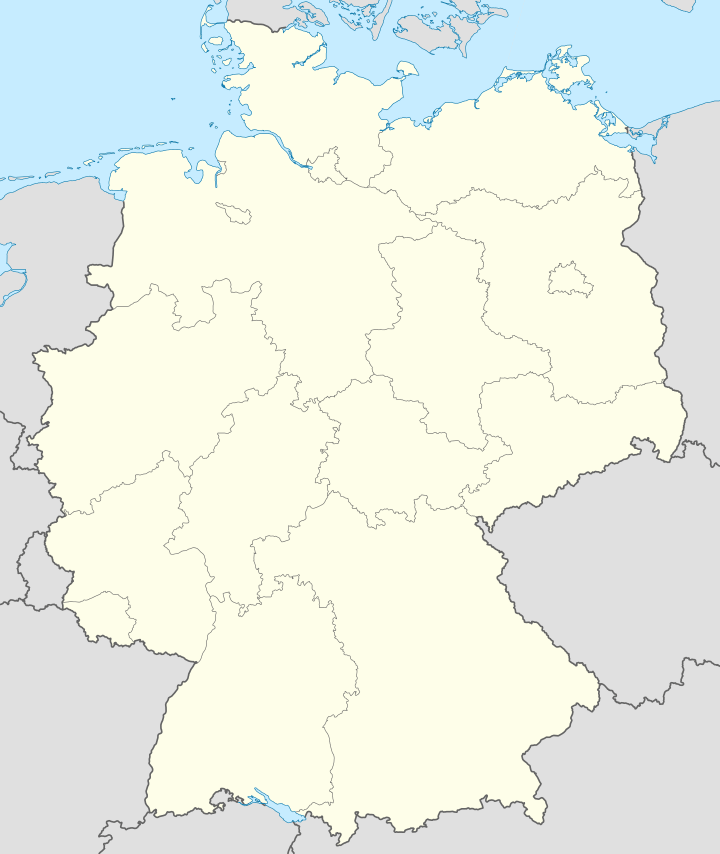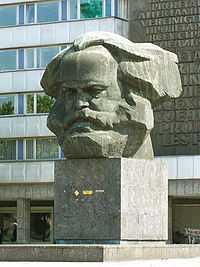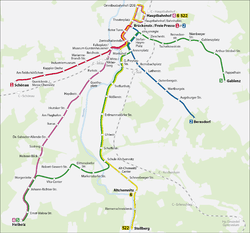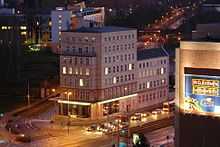Chemnitz
| Chemnitz | |||
|---|---|---|---|
|
View over Chemnitz | |||
| |||
 Chemnitz | |||
| Coordinates: 50°50′N 12°55′E / 50.833°N 12.917°ECoordinates: 50°50′N 12°55′E / 50.833°N 12.917°E | |||
| Country | Germany | ||
| State | Saxony | ||
| District | Urban districts of Germany | ||
| Government | |||
| • Mayor | Barbara Ludwig (SPD) | ||
| Area | |||
| • Total | 220.85 km2 (85.27 sq mi) | ||
| Population (2013-12-31)[1] | |||
| • Total | 242,022 | ||
| • Density | 1,100/km2 (2,800/sq mi) | ||
| Time zone | CET/CEST (UTC+1/+2) | ||
| Postal codes | 09001–09247 | ||
| Dialling codes |
0371 037200 (Wittgensdorf) 037209 (Einsiedel) 03722 (Röhrsdorf) 03726 (Euba) | ||
| Vehicle registration | C | ||
| Website | chemnitz.de | ||
Chemnitz (German pronunciation: [ˈkɛmnɪt͡s]; known from 1953 to 1990 as Karl-Marx-Stadt) is the third-largest city in the Free State of Saxony, Germany. Chemnitz is an independent city which is not part of any county and seat of the Freistaat Sachsen. Located in the northern foothills of the Ore Mountains, it is part of the Central German Metropolitan Region. The city's economy is based on the service sector and manufacturing industry. Chemnitz University of Technology has around 10,000 students.
Etymology
Chemnitz is named after the river Chemnitz, a small tributary of the Zwickauer Mulde. The word "Chemnitz" is from the Sorbian language (Upper Sorbian: Kamjenica), and means "stony [brook]". The word is composed of the Slavic word kamen meaning "stone" and the feminine suffix -ica. It is known in Czech as Saská Kamenice and in polish as Kamienica Saska. There are many other towns named Kamenica or Kamenice in areas with past or present Slavic settlement.
History

An early Slavic tribe's settlement was located at Kamienica, and the first documented use of Chemnitz was the 1143 site of a Benedictine monastery around which a settlement grew. Circa 1170 Frederick I, Holy Roman Emperor granted it the rights of an imperial city. In 1307, the town became subordinate to the margraviate of Meissen (the predecessor of the Saxon state). In Medieval Times Chemnitz became a centre of textile production and trade. More than one third of the population worked in textile production.
By the early 19th century Chemnitz had become an industrial centre (sometimes called "the Saxon Manchester"). In 1913, Chemnitz had a population of 320,000 and, like Leipzig and Dresden, was larger at that time than today. After losing inhabitants due to the first World War Chemnitz grew rapidly again and reached its all-time peak of 360,250 inhabitants in 1930. Before the world economic crises, it was supposed that the city would keep on growing and would become a "Millionenstadt" (engl. Megacity, literally: city with at least one million inhabitants) by incorporating also fast growing smaller towns and municipalities around it.
During World War II, Chemnitz contained factories that produced military hardware and a Flossenbürg forced labor subcamp (500 female inmates) for Astra-Werke AG.[2] The oil refinery was a target for bombers during the Oil Campaign of World War II, and Operation Thunderclap attacks included the following raids:
- 14/15 February 1945: The first major raid on Chemnitz used 717 RAF bombers, but due to cloud cover most bombs fell over open countryside.
- 2/3–5 March: USAAF bombers attacked the marshalling yards.[3]
- 5 March: 760 RAF bombers attacked.
The headquarters of the auto manufacturer Auto Union were also based in Chemnitz since 1932 and its buildings were also badly damaged. At the end of the war, the company's executives fled and relocated the company in Ingolstadt, Bavaria, where it evolved into Audi, now a brand within the Volkswagen group.
The World War II bombings left most of the city in ruins, and post-war, the East German reconstruction included large low rise (and later high-rise plattenbau) housing. Some tourist sites were reconstructed during the East German era and after German reunification. It was occupied by Soviet troops on 8 May 1945.
From 10 May 1953 to 21 June 1990, Chemnitz was named Karl-Marx-Stadt (literally Karl Marx City, though the German term was also used in English).
Sights
Tourist sights include the Kassberg neighborhood with 18th and 19th century buildings and the Karl Marx Monument by Lev Kerbel, nicknamed "Nischel" (a Saxon dialect word for head) by the locals. Landmarks include the Old Town Hall with its Renaissance portal (15th century), the castle on the site of the former monastery, and the area around the opera house and the old university. The most conspicuous landmark is the red tower built in the late 12th or early 13th century as part of the city wall.
The Chemnitz petrified forest is located in the courtyard of Kulturkaufhaus Tietz. It is one of the very few in existence, and dates back several million years. Also within the city limits, in the district of Rabenstein, is the smallest castle in Saxony, Rabenstein Castle.
The city has changed considerably since German reunification. Most of its industry is now gone and the core of the city has been rebuilt with many small shops as well as huge shopping centres. Many of these shops have well known names, including Zara, H & M, Esprit, Galeria Kaufhof, Leiser Shoes, and Peek & Cloppenburg. The large "Galerie Roter Turm" (Red Tower) shopping centre is very popular with young people.
The Chemnitz Industrial Museum is an Anchor Point of ERIH, the European Route of Industrial Heritage.
The Museum Gunzenhauser, formerly a bank, opened on 1 December 2007. Dr Alfred Gunzenhauser, who lived in Munich, had a collection of some 2,500 pieces of modern art, including many paintings and drawings by Otto Dix, Karl Schmidt-Rottluff and others. The Botanischer Garten Chemnitz is a municipal botanical garden, and the Arktisch-Alpiner Garten der Walter-Meusel-Stiftung is a non-profit garden specializing in arctic and alpine plants.
-

Old and new city hall
-

Chemnitz Opera at Opernsquare
-
St. Petri church
-

Luther's church
-
Castle church over the Chemnitz river
-
The Mercure Hotel, tallest building in Chemnitz
-

The Transparent department store
-

View over Falkeplatz during night time
-

Bust of Karl Marx, the city's erstwhile namesake
-

View over the city halls and the inner city (under construction)
-

Chemnitz-Kulturhaus
-

Watercastle Klaffenbach
-
Chemnitz Stadtbad
-

Guest houses at Castle park
-

Chemnitz petrified forest inside the Kulturkaufhaus Tietz
Urban renewal
Heavy destruction in World War II as well as post-war demolition to erect a truly socialist city centre left the city with a vast open space around its town hall where once a vibrant city heart had been. Because of massive investment in out-of-town shopping right after reunification, it was not until 1999 that major building activity was started in the centre. Comparable to Potsdamer Platz in Berlin, a whole new quarter of the city was constructed in recent years. New buildings include the Kaufhof Department store by Helmut Jahn, Galerie Roter Turm with a façade by Hans Kollhoff and Peek & Cloppenburg clothing store by Ingenhofen and Partner.

Economy
Chemnitz is the largest city of the Chemnitz-Zwickau urban area and is one of the most important economic areas of Germany's new federal states. Chemnitz had a GDP of about €6.3 billion in 2004. Since about 2000, the city's economy has recorded high annual GDP growth rates; Chemnitz is among the top ten German cities in terms of growth rate. The local and regional economic structure is characterized by medium-sized companies, with the heavy industrial sectors of mechanical engineering, metal processing, and vehicle manufacturing as the most significant industries.
Over several years, the unemployment rate has steadily decreased to 13.9% (July 2007). About 100,000 people are employed, of whom about 46,000 commute from other municipalities.[4] 16.3% of employees in Chemnitz have a university or college degree, twice the average rate in Germany.
Demography

After German reunification Saxony faced a significant population decrease. Since 1990 Chemnitz has lost more than 20 percent of its inhabitants. In 2006 the BBC reported the city of Chemnitz had the lowest birth rate in the world.[5]
Number of minorities in Chemnitz by nationality as of 2012:
| Rank | Nationality | Population (2012) |
|---|---|---|
| 1 | 1,092 | |
| 2 | 767 | |
| 3 | 643 | |
| 4 | 383 | |
| 5 | 327 | |
| 6 | 313 | |
| 7 | 254 | |
| 8 | 243 | |
| 9 | 187 | |
| 10 | 158 | |
Transport


Roads
Chemnitz is crossed by the two motorways (Autobahn) A4 Erfurt – Dresden and A72 Hof – Leipzig. The motorway junction Kreuz Chemnitz is situated in the northwestern area of the city. The motorway A72 between Borna and Leipzig is still under construction. Within the administrative area of Chemnitz there are eight motorway exits (Ausfahrt).
Public transport
Public transport within Chemnitz is provided with tram and bus, as well as by the Stadtbahn. Nowadays, the city and its surroundings are served by one Stadtbahn line, five lines of the Chemnitz tramway network, 27 city bus lines, as well as several regional bus lines. At night, the city is served by two bus lines, two tram lines, and the Stadtbahn line.
The length of the tram, Stadtbahn and bus networks is 28.73 km (17.85 mi), 16.3 km (10.13 mi) and 326.08 km (202.62 mi) respectively. In August 2012, electro-diesel trams were ordered from Vossloh, to support an expansion of the light rail network to 226 km (140 mi), with new routes serving Burgstädt, Mittweida and Hainichen.[6]
Airports
Near Chemnitz there are three airports, including the two international airports of Saxony in Dresden and Leipzig. Both Leipzig/Halle Airport and Dresden Airport are situated about 70 km (43 mi) from Chemnitz and offer numerous continental as well as intercontinental flights.
Chemnitz also has a small commercial airport (Verkehrslandeplatz Chemnitz Jahnsdorf) about 13.5 km (8.4 mi) south of the city. When its current upgrade is completed it will have an asphalt runway 1,400 m (4,600 ft) long and 20 m (66 ft) wide.
Sports
- Chemnitzer FC (football)
- BV Chemnitz 99 (basketball)
- VfB Fortuna Chemnitz (football)
- Post SV Chemnitz (swimming)
- Schwimmclub Chemnitz v. 1892 e.V. (swimming)
- TSV Einheit Süd Chemnitz (swimming, Gymnastics, Volleyball, skittles)
- ERC Chemnitz e.V. (ice hockey, skater hockey)
- CTC-Küchwald (tennis)
- Floor Fighters Chemnitz (floorball)
- ESV LOK Chemnitz (luge)
- Chemnitzer EC (figure skating, Ice dancing, Curling)
- Chemnitz Crusaders (American Football)
- Tower Rugby Chemnitz (Rugby)
- SV Eiche Reichenbrand (football)
Famous residents
- Peter-Klaus Budig (1928–2012), Hochschullehrer, Politiker und Geschäftsführer
- Stefan Heym (1913–2001), author
- John Kluge (1921–2010), German-American billionaire and media mogul
- Helga Lindner (born 1951), swimmer; Olympic silver medalist
- Max Littmann (1862–1931), architect
- Anja Mittag (born 1985), footballer, World Champion 2007
- Frederick and William Nevoigt, founders of the Diamant bicycle brand
- Sylke Otto (born 1969), luger
- Siegfried Rapp (1915–1982), one-armed German pianist
- Frank Rost (born 1973), football goalkeeper, currently playing for New York Red Bulls
- Karl Schmidt-Rottluff (1884–1976), painter
- Ingo Steuer (born 1966), figure skater
- Mandy Wötzel (born 1973), figure skater
- Klaus Wunderlich (1931–1997), organist
- Alva Noto (born 1965), sound artist
- Aliona Savchenko and Robin Szolkowy, ice figure skaters: World Champion 2008, 2009, 2011, 2012, 2014; Olympic Bronze Medalist 2010, 2014
- Matthias Steiner, weightlifter, Olympic Gold Medalist 2008
- Matthias Schweighöfer (born 1981), actor and film director
Honorary citizens
- Karl Schmidt-Rottluff (1884–1976), painter
- Waleri Bykowski (born 1934), astronaut
- Sigmund Jähn (born 1937), astronaut
- Stefan Heym (1913–2001), German-Jewish writer
- Marianne Brandt, (1893–1983), artist, designer
International relations
Twin towns – sister cities
Chemnitz is twinned with:
|
References
- ↑ "Statistisches Landesamt des Freistaates Sachsen – Bevölkerung des Freistaates Sachsen jeweils am Monatsende ausgewählter Berichtsmonate nach Gemeinden" (PDF). Statistisches Landesamt des Freistaates Sachsen (in German). 6 September 2014.
- ↑ Victor, Edward. "Chemnitz, Germany". Retrieved 23 March 2009.
- ↑ COMBAT CHRONOLOGY OF THE US ARMY AIR FORCES http://paul.rutgers.edu
- ↑ Internetseite des Bundestagsabgeordneten Detlef Müller (SPD) mit Kennzahlen zur Chemnitzer Wirtschaft
- ↑ "German births decline to new low". BBC NEWS. 15 August 2006. Retrieved 2 January 2010.
- ↑ "Chemnitz orders electro-diesel tram-trains – Railway Gazette". Railway Gazette International. Retrieved 19 August 2012.
- ↑ "Medmestno in mednarodno sodelovanje". Mestna občina Ljubljana (Ljubljana City) (in Slovenian). Retrieved 2013-07-27.
- ↑ "Miasta partnerskie – Urząd Miasta Łodzi [via WaybackMachine.com]". City of Łódź (in Polish). Archived from the original on 24 June 2013. Retrieved 2013-07-21.
- ↑ "Twin Towns". www.amazingdusseldorf.com. Retrieved 29 October 2009.
External links
 Media related to Chemnitz at Wikimedia Commons
Media related to Chemnitz at Wikimedia Commons The dictionary definition of chemnitz at Wiktionary
The dictionary definition of chemnitz at Wiktionary Chemnitz travel guide from Wikivoyage
Chemnitz travel guide from Wikivoyage- (German) Official site of Chemnitz
| ||||||||||||||||||
| ||||||||






.jpg)



